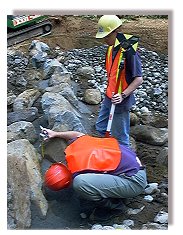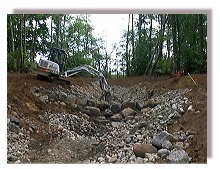Weir the
Waters
By Damien Barstead
When constructing a stream in urban areas, concerns for property damage are high.
The ability to regulate the amount of water flowing down the creek channel is essential to the
prevention of flooding. This is a dilemma caused by the lower reaches of the new Haig-Brown
Kingfisher Creek. The problem in this area is that most of the stream channel in the lower
reaches has a virtually 0% gradient. This presents the problem of how to keep the waters
moving, while preventing excessive flooding to the surrounding areas.
The answer, in this case, is the construction of dam-like weirs made with a high
degree of precision. These weirs act in the same way as a larger scale dam would. Deeper areas
are dug above the weirs, allowing water levels to rise. Once the height of water is equal to that of
the weir, spillover occurs, and the water flows into the next, slightly lower, flat section and
builds to the height of the next weir. In total, three weirs will be constructed in the lower 170
meters of the new channel, and will be positioned at about 60m, 80m, and 170m from the
creek's confluence with the West branch.

Attaining the exact height of the
new weir is extremely
important to
help control flows in the system.
Given the insignificant drop in each section (6 cm), a very high degree of precision is
needed when excavating the bottom of the stream channel and building up the height of the
weirs.
|
Before constructing the weirs, the streambed around and under the weirs must first
be strengthened to provide support and to prevent seepage during low flows. This is done by
compacting about five layers of clay in the streambed, and then armoring the surface with
boulders and cobble.

Looking upstream
towards one of the new
weirs.
The weirs themselves will be made out of a combination of cement, rock, and wood.
For example, the weir pictured above is predominately cement, and is lined with boulders along
its top edge to allow water to continue to flow, even when the quantity flowing is meagre. Wood
will be incorporated into the design once the weir is constructed. The design of the other two
weirs will be similar to the one above, with differences being primarily due to the need to adapt
them to their surrounding channel.
Once constructed, these weirs will hopefully maintain a relatively consistent flow
rate, as well as controlling the water during flood events. At times of low or no water flow, the
areas between the weirs will form pools which may allow fish to survive when they otherwise
might be stranded. The completion of all three of the weirs is should be accomplished by the end
of this week. Check out the next few issues of the Creekside News to find out...
Top of page.
|

